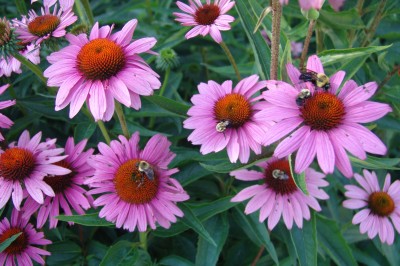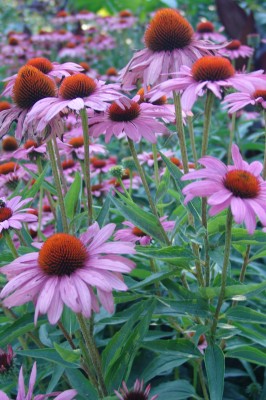Echinacea purpurea 'Rubinstern'
Next time you walk along College Ave. past the Scott Arboretum office, be sure to notice the beautiful display of Echinacea purpurea ‘Rubinstern’. This relatively new purple coneflower is an improved cultivar of E. purpurea ‘Magnus’, the 1998 Perennial Plant of the Year, awarded by the Perennial Plant Association. Breeding efforts in the development of ‘Rubinstern’ have resulted in more uniformly-sized plants and larger, darker flowers. ‘Rubinstern’ will produce intense carmine-red blossoms from July through September and, like other E. purpurea cultivars, takes full sun and is a wonderful bee and butterfly attractor!
The roots and rhizomes of Echinacea plants have long been used to treat the common cold and to bolster the immune system. However, recent scientific studies question the medicinal efficacy of Echinacea. Regardless of its medicinal benefits, there is no doubt that it is a striking perennial for any garden. Due to advances in Echinacea breeding, the availability of purple coneflower cultivars has exploded in the past few years. Whereas a decade ago, Echinacea flowers were pretty much limited to purple- and white-colored cultivars, you can now find purple coneflowers in shades of orange, gold, and mango, with over 30 cultivars to choose from!
A few interesting Echinacea facts:
- To meet increasing market demand for new cultivars, purple coneflowers are propagated in labs using tissue culture. With the application of plant hormones, one piece of a purple coneflower plant in a lab dish can produce thousands of tiny new plants.
- Echinacea is self-incompatible, in that one plant cannot successfully pollinate its own flowers. This means that purple coneflowers depend on bees and other insects to transfer pollen from one plant to the next. So, when you pass by ‘Rubinstern’, be sure to thank the busy bees hard at work!
- The genus name Echinacea comes from the Greek word for hedgehog, echinos, referring to the flower’s spiny cone center.







No Comments